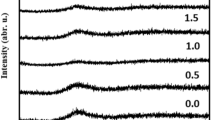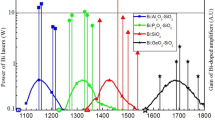Abstract
The spectral and luminescent properties of bismuth-containing germanate glass (0.1 and 1.0 mol % Bi2O3) were studied as a function of redox synthesis conditions. CeO2 and CaF2 were introduced into the glass charge as oxidants. The temperature of glass synthesis (1500–1600°C) was a factor that stimulated the reduction processes in the melt. It was shown that the absorption coefficient of glass in the spectral visible region decreased with an increased concentration of oxidants in the charge; and the narrowing of the luminescence band in the region of 1100 nm at excitation at 532 nm was observed. Similar effects were observed at a decrease of the temperature of the glass synthesis to 1500°C. It is assumed that the optically active centers in the resulting glass are the bismuth ions in the oxidation state below 3+. The concentration of these centers in the glass can be controlled by changing the redox balance of the synthesis conditions.
Similar content being viewed by others
References
Bufetov, I.A. and Dianov, E.M., Bi-doped fiber lasers, Laser Phys. Lett., 2009, vol. 6, no. 7, p. 487.
Peng, M., Zollfrank, C., and Wondraczek, L., Origin of broad NIR photoluminescence in bismuthate glass and Bi-doped glasses at room temperature, J. Phys.: Condens. Matter, 2009, vol. 21, no. 28, p. 285106.
Peng, M., Da, N., Krolikowski, S., Stiegelschmitt, A., and Wondraczek, L., Luminescence from Bi2+-activated alkali-earth borophosphates for white LEDs, Opt. Express, 2009, vol. 17, no. 23, pp. 21169–21178.
Peng, M. and Wondraczek, L., Photoluminescence of Sr2P2O7: Bi2+ as a red phosphor for additive light generation, Opt. Lett., 2010, vol. 35, no. 15, pp. 2544–2546.
Peng, M. and Wondraczek, L., Bi2+-doped strontium borates for white-light-emitting diodes, Opt. Lett., 2009, vol. 34, no. 19, pp. 2885–2887.
Fujimoto, Y. and Nakatsuka, M., Infrared luminescence from bismuth-doped silica glass, Jpn. J. Appl. Phys., 2001, vol. 40, no. 3B, pp. L279–L281.
Cao, R., Peng, M., Wondraczek, L., and Qiu, J., Superbroad near-to-mid-infrared luminescence from Bi 3+5 in Bi5(AlCl4)3, Opt. Express, 2012, vol. 20, no. 3, pp. 2562–2571.
Khonthon, S., Morimoto, S., Arai, Y., and Ohishi, Y., Luminescence characteristics of Te- and Bi-doped glasses and glass-ceramics, J. Ceram. Soc. Jpn., 2007, vol. 115, no. 1340, pp. 259–263.
Sokolov, V.O., Plotnichenko, V.G., and Dianov, E.M., Origin of broadband near-infrared luminescence in bismuth-doped glasses, Opt. Lett., 2008, vol. 33, no. 13, pp. 1488–1490.
Nielsen, K.H., Smedskjaer, M.M., Peng, M., Yue, Y.Z., and Wondraczek, L., Surface-luminescence from thermally reduced bismuth-doped sodium aluminosilicate glasses, J. Non-Cryst. Solids, 2012, vol. 358, pp. 3193–3199.
Weyl, W.A., Coloured Glasses, Sheffield, United Kingdom: Society of Glass Technology, 1999, 5th ed.
Jiang, X. and Jha, A., An investigation on the dependence of photoluminescence in Bi2O3-doped GeO2 glasses on controlled atmospheres during melting, Opt. Mater., 2010, vol. 33, no. 1, pp. 14–18.
Shelby, J.E., Introduction to Glass Science and Technology, London: Royal Society of Chemistry, 2005, p. 308.
Shifeng Zhou, Gaofeng Feng, Jiaxing Bao, Hucheng Yang, and Jianrong Qiu, Broadband near-infrared emission from Bi-doped aluminosilicate glasses, J. Mater. Res., 2011, vol. 22, p. 1435.
Denker, B., Galagan, B., Osiko, V., Sverchkov, S., and Dianov, E., Luminescent properties of Bi-doped boroalumino-phosphate glasses, Appl. Phys. B: Lasers Opt., 2007, vol. 87, no. 1, p. 135.
Galagan, B.I., Denker, B.I., Lili, Hu., Sverchkov, S.E., Shulman, I.L., and Dianov, E.M., Effect of variable valence impurities on the formation of bismuth-related optical centres in a silicate glass, Quantum Electron., 2012, vol. 42, no. 10, pp. 940–942.
Winterstein, A., Manning, S., Ebendorff-Heidepriem, H., and Wondraczek, L., Luminescence from bismuth-germanate glasses and its manipulation through oxidants, Opt. Mater., 2012, vol. 2, no. 10, pp. 1320–1328.
Rojas, S.S., De Souza, J.E., Andreeta, M.R.B., and Hernandes, A.C., Influence of ceria addition on thermal properties and local structure of bismuth germanate glasses, J. Non-Cryst. Solids, 2010, vol. 356, nos. 52–54, pp. 2942–2946.
Pynenkov, A.A., Firstov, S.V., Panov, A.A., Firstova, E.G., Nishchev, K.N., Bufetov, I.A., and Dianov, E.M., IR luminescence in bismuth-doped germanate glasses and fibres, Quantum Electron., 2013, vol. 43, no. 2, pp. 174–176.
Peng, M., Wang, C., Chen, D., Qiu, J., Jiang, X., and Zhu, C., Investigations on bismuth and aluminum co-doped germanium oxide glasses for ultra-broadband optical amplification, J. Non-Cryst. Solids, 2005, vol. 351, nos. 30–32, pp. 2388–2393.
Author information
Authors and Affiliations
Corresponding author
Additional information
Original Russian Text © A.A. Pynenkov, K.N. Nishchev, S.V. Firstov, A.P. Sivko, 2015, published in Fizika i Khimiya Stekla.
The work is published based on the materials of the Conference on “Glass: Science and Practice” held on November 6–8, 2013 in St. Petersburg, Russia.
Rights and permissions
About this article
Cite this article
Pynenkov, A.A., Nishchev, K.N., Firstov, S.V. et al. Influence of redox synthesis conditionson the spectral and luminescent properties of germanate glass activated by bismuth ions. Glass Phys Chem 41, 108–111 (2015). https://doi.org/10.1134/S1087659615010241
Received:
Published:
Issue Date:
DOI: https://doi.org/10.1134/S1087659615010241




